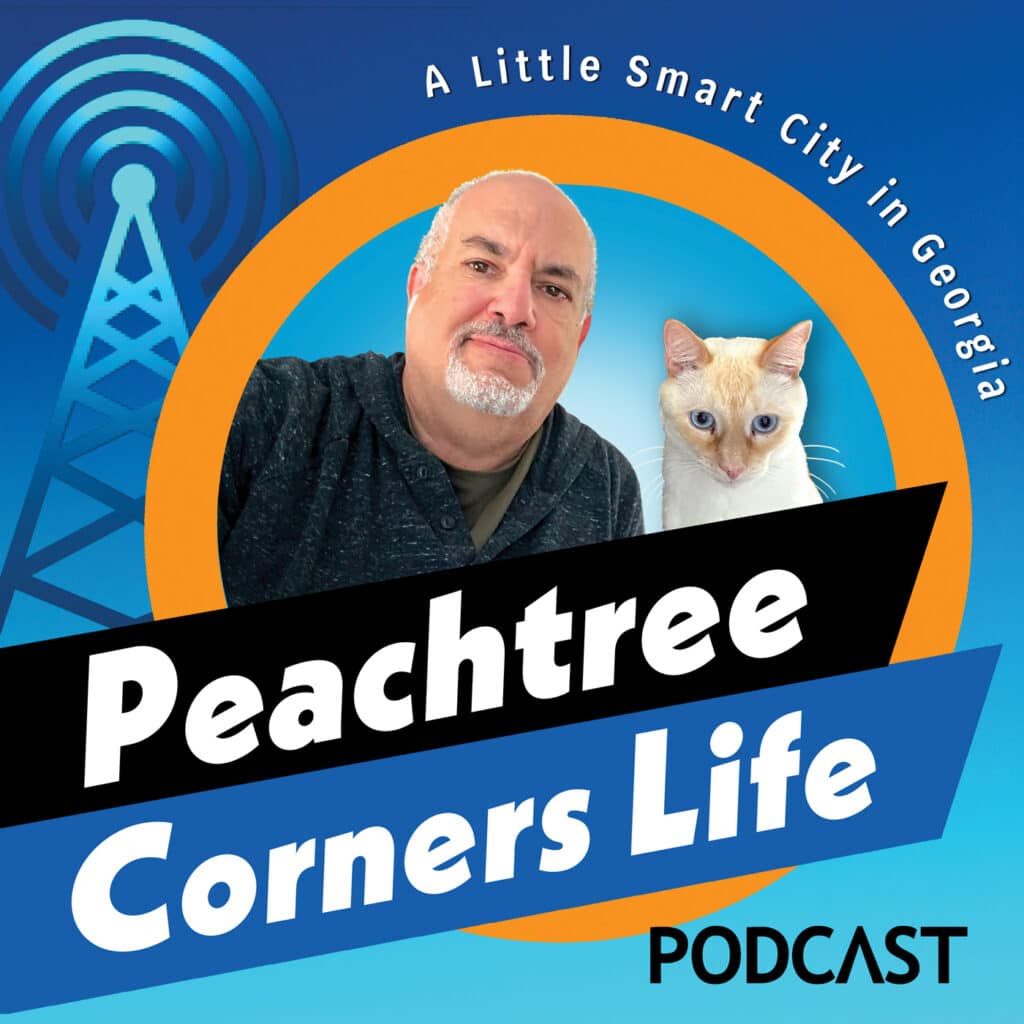Community
Looking Up: Two Peachtree Corners residents show enthusiasm for things that fly
Published
5 years agoon
By
Joe Earle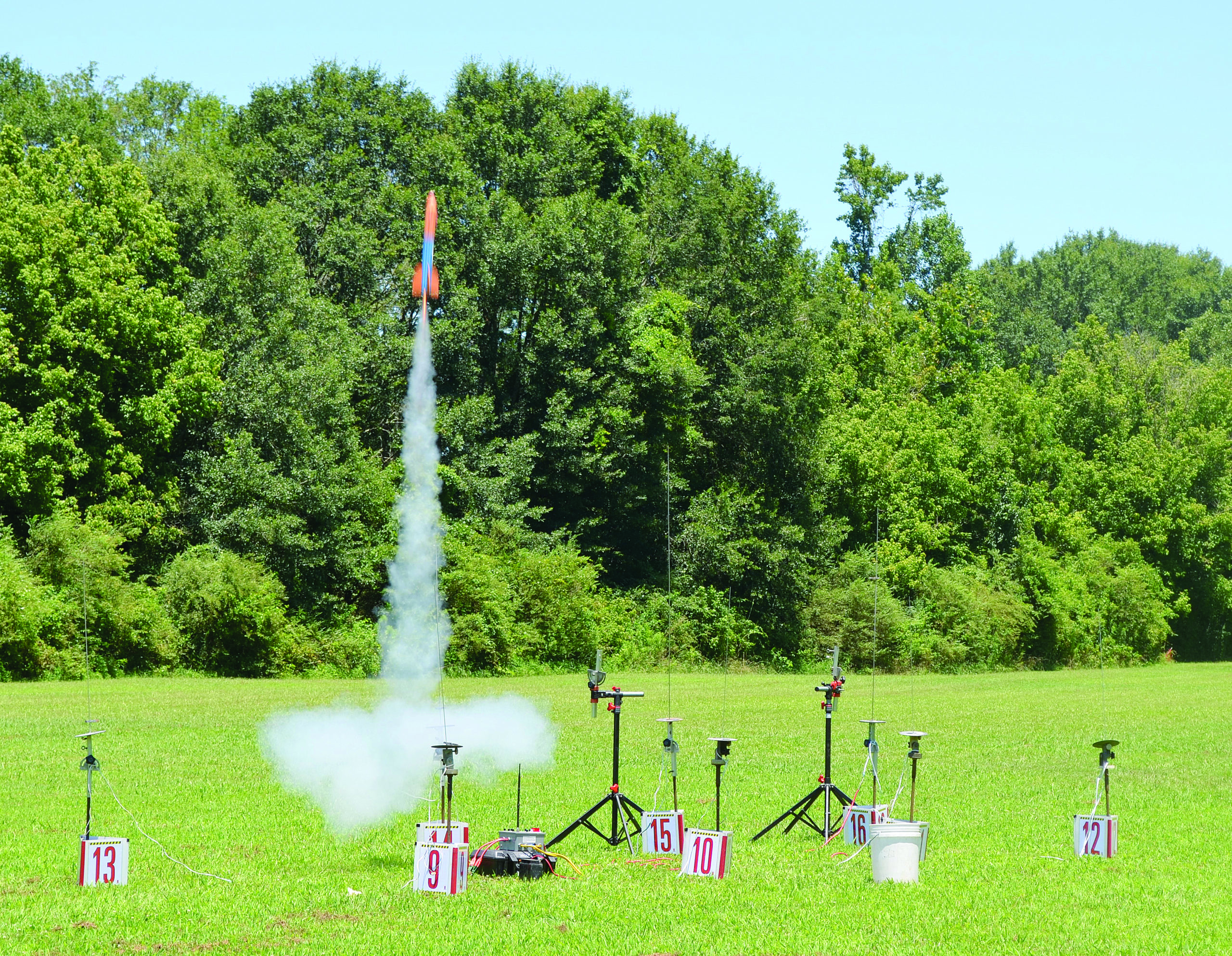
One hot Saturday in July, a cloudless sky burned deep blue above an isolated field hidden among the woods behind a private high school in Atlanta’s northern suburbs. About 20 cars, pickups or SUVs lined the edge of the grassy field and families gathered beneath tents or tarps they’d pitched beside their vehicles, like tailgaters at a football game. In the middle of the field, a pair of model rockets sat side by side on launch pads, waiting the electronic command to blast skyward.
One belonged to Maddie Cain, a 9-year-old from Peachtree Corners who enjoys flying rockets with her dad. She and Nicolas Ruthruff, a 7-year-old friend from Acworth, planned to launch their rockets side-by-side in a “drag race,” a competition to see how well each rocket performed. The winner would be the last rocket to hit ground. Jorge Blanco, president of the Southern Area Rocketry club (SoAR), stood in the shadow beneath a tarp next to the launch area. Blanco counted down from five to zero and the rockets zipped into the sky. After just a few seconds, they headed back to earth. Nicholas’ rocket won. The two rocket racers ran across the mowed grass to collect their models so they could fly another day. “Good race,” Maddie said.
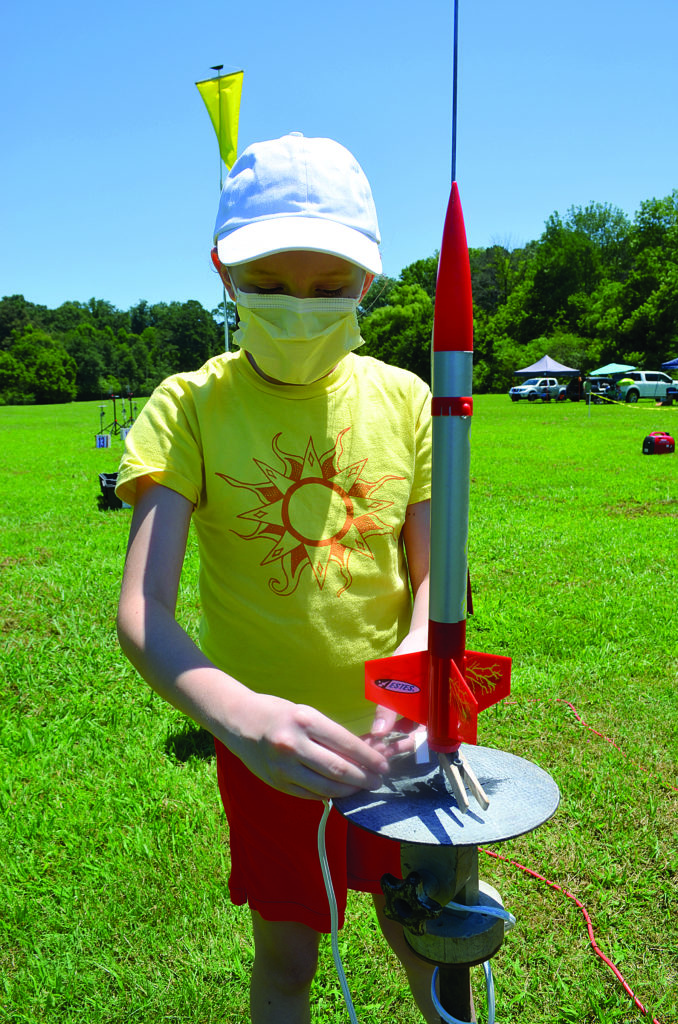
Maddie learned about model rocketry from her dad, David Cain. Cain, a 61-year-old software interface architect, first flew model rockets as a boy who was, as he put it, “growing up in the Space Age.” He moved on to other interests as a teenager, he said, but picked up the hobby again a few years ago as a common interest with his children, Maddie and her 12-year-old brother Jim. This year, Cain took over as vice president of the 400-member SoAR.
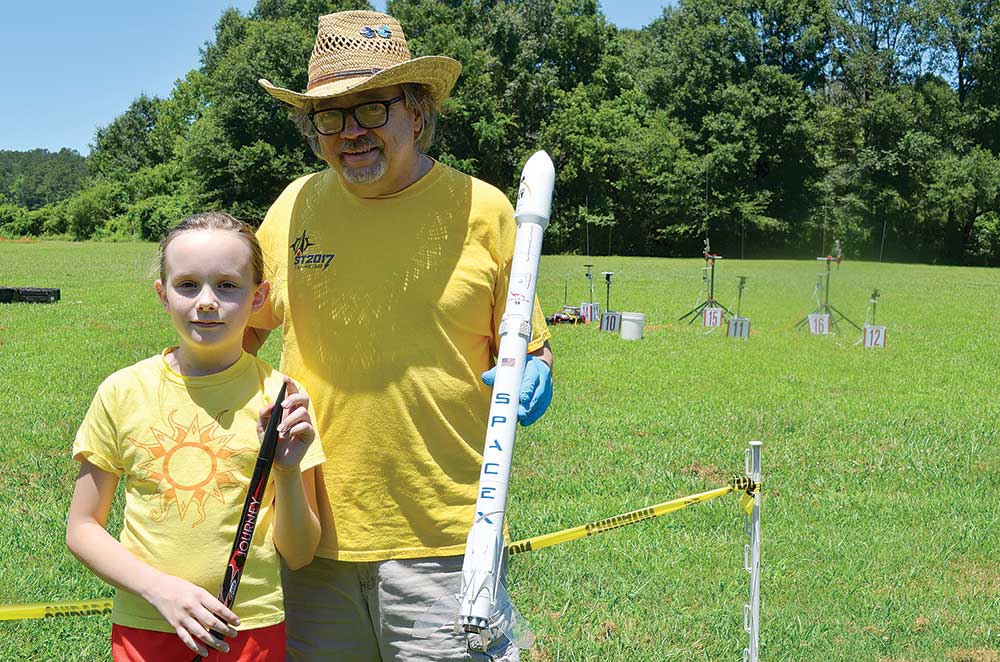
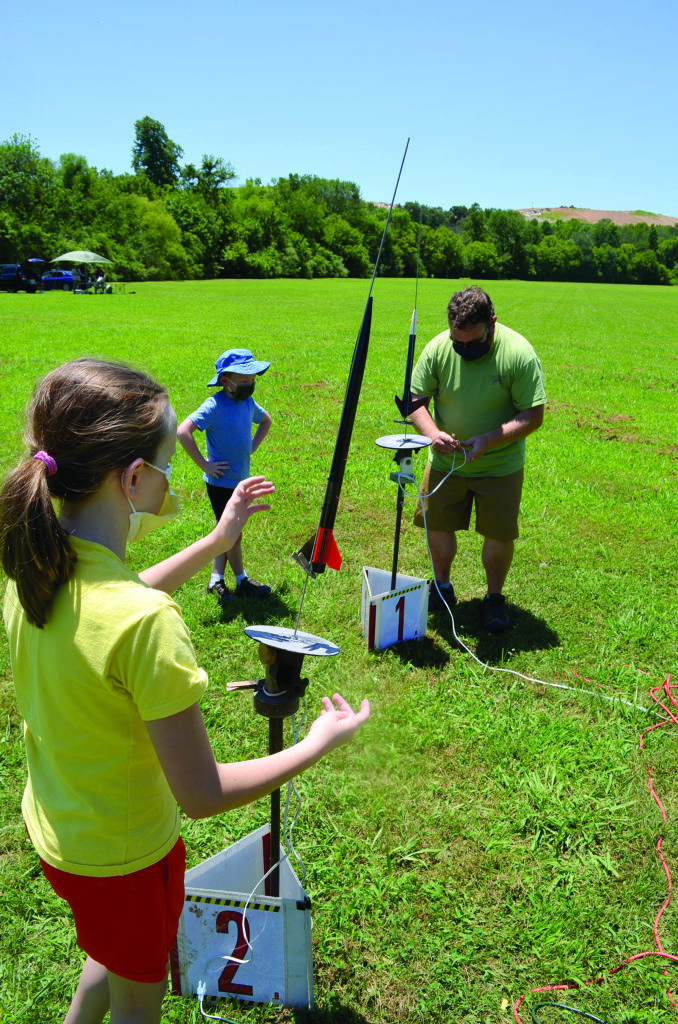
These days, he and another Peachtree Corners resident, Moreno Aguiari, are working to help introduce metro Atlantans to machines that fly.
New kind of aviation museum
While Cain engages in model rocketry, Aguiari, a 44-year-old commercial pilot and publisher of a magazine about vintage warplanes, wants to help create a new museum and education center built around Georgia’s aviation history and industry. The new Atlanta Air and Space Museum is proposed for 18 acres on the eastern side of the DeKalb-Peachtree Airport, the county-owned airport in Chamblee usually referred to by its call letters, PDK. The property, once used for a runway but now abandoned, offers a close view of PDK’s working runways and airport facilities.
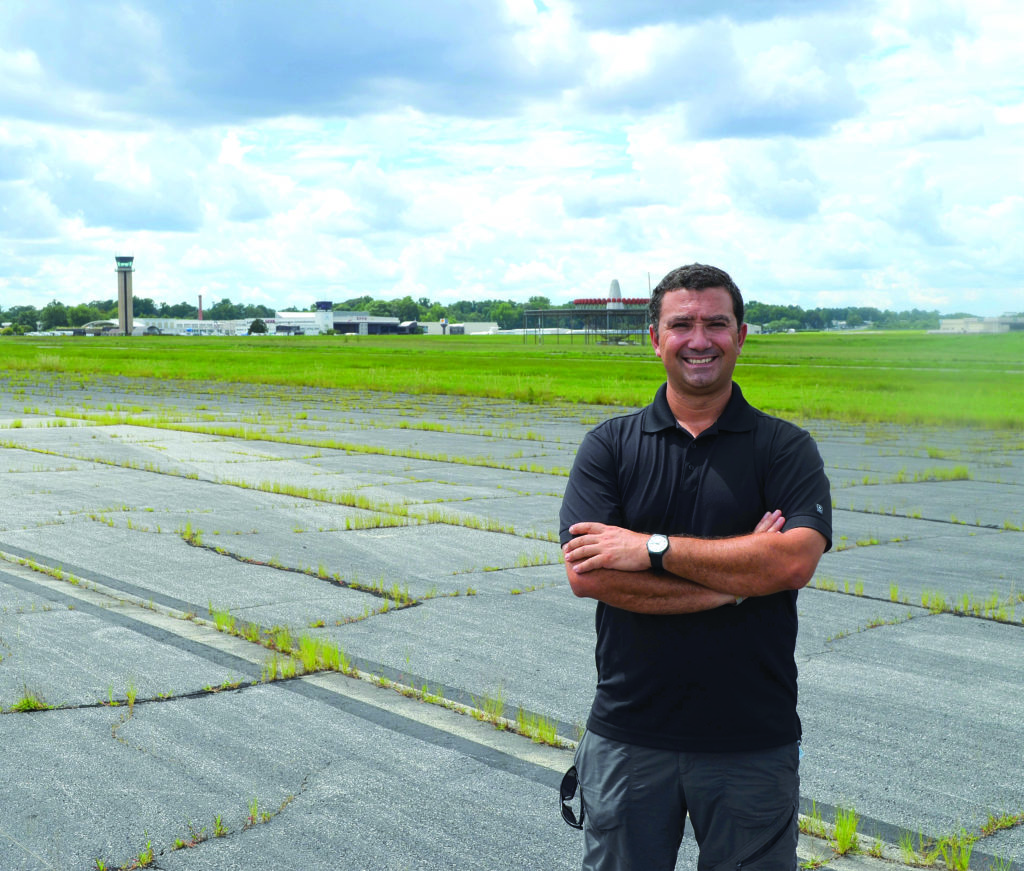
Aguiari is a founder and board member of the Inspire Aviation Foundation, a nonprofit created about three years ago to create the museum. “The purpose of this museum would be to acquire, restore and conserve historic aircraft, spacecraft, technology and related artifacts, while creating innovative visitor experiences that are educational and entertaining,” the foundation said in a press release.
Aguiari puts it a bit more simply. The museum’s proponents, he said, don’t want simply to create another building full of old airplanes, like plenty of other aviation museums scattered around the country. “We are not going to build your typical box full of planes,” Aguiari said as he sat in a conference room at PDK once recent afternoon. “That’s an old concept of a museum.”
Instead, they see exhibits that are interactive and engaging to young people. They want the DeKalb School System and perhaps even Georgia Tech to be involved with the aviation campus to create a place where students can learn about aerospace careers and flying.
The foundation wants to create a place “designed to build aspiration for a life in Science, Technology, Engineering, Arts and Mathematics (STEAM),” it said in its press release. “But the platform will go further than aspirations to nurture an interest in aviation throughout someone’s entire life. The [foundation] wants to offer a tangible path from childhood all the way through an aerospace career and beyond.”
Aguiari realized the PDK museum should be different when he was taking his own children to see other aviation museums. He liked looking at the old planes, he said, but his kids soon were bored. “My 5- and 6-year-old kids were telling me, ‘Dad, can we go someplace else? Nothing moves here.’”
Fellow foundation board member Latessa Meader, a C-130 pilot in the U.S. Air Force Reserve, got excited about and signed on with the project last year because of its educational components. She’s a former high school math teacher who says she became an aviation mechanic and then a pilot because she thought the most interesting teachers were those who had done other things during their lives.
“We don’t want static airplanes with placards in front of them,” she said. “All of us have a passion for aviation and we want to inspire that in students from age 1 to 100.”
She said she wants the project to showcase careers in aviation and aerospace and show students how to pursue jobs as engineers, air traffic controllers, mechanics or baggage handlers. “Anything you enjoy doing can be [related to aviation],” she said. “One of my long-term goals in this is to capture their passions.”
The museum would tell the story of aviation in Georgia. Georgians have built airplanes at Lockheed Martin and Gulfstream, flown them for Delta Air Lines and operated the busiest airport in the world. “Georgia has an incredible aviation history [stretching back] almost 120 years,” Aguiari said.
Georgia’s aviation heritage
Georgians were building and flying airplanes soon after the Wright brothers showed it was possible. One of the nation’s aviation pioneers was Ben Epps of Athens, whose descendants made flying a family tradition that continues. His youngest son, Pat Epps, started Epps Aviation, the fixed based operator still in business at PDK.
The land that would become PDK was part of the site of Camp Gordon, a World War I army training base. The property was sold at auction after the war to a private owner, and then in the 1920s and early 1930s, aviation enthusiasts thought the land would make a good airport, according to the PDK webpage. In 1940, DeKalb County bought the land and dirt runways and opened it in 1941, the webpage says.
During World War II, the property was home to a U.S. Naval Air Station. “Many young men, not only from Georgia but from all over the United States, began their flying careers during the next few years, while the Navy was using the airport for pilot training,” the PDK webpage says.
After the war, the Navy continued to operate the airport as a Naval Air Station until a new facility that could handle jets opened at Dobbins Air Force Base in Cobb County. PDK returned to full civilian use in 1959.
One of the first collections the aviation museum has received is composed of memorabilia from retirees of the Naval Air Station. The collection includes photographs, logbooks, newspaper clippings and other artifacts that had been displayed during annual meetings of the retirees. The foundation is having the items photographed so they can be preserved digitally, Aguiari said. With the items, the museum can showcase the air station’s history so “the guys who served here will not be forgotten.”
Efforts to pull together the aviation museum and to develop the campus are expected to take at least three to five years, Meader said. The foundation is conducting a feasibility study for the project and for fundraising for the millions of dollars needed for the project, Aguiari said. He remains hopeful.
“I’m just a regular Joe with a big vision,” Aguiari said. “It’s not like we have millionaires or big companies behind it. It’s just a bunch of regular guys trying to build something incredible.”
Soaring high
David Cain pursues a different vision. He still regularly fires small kit rockets similar to ones his daughter Maddie and Jim build and fly, but he’s also looking up to see just how high some of his models can soar and survive.
SoAR organizes launch days for small rockets every month. (The launches are open to anyone who wants to fly rockets, not just members). But its members also take part, a few times a year, in high altitude flights from fields in south Georgia, Alabama or other places far from the flight paths of airplanes. Cain has taken part in a few of those outings. He said his collection now includes three high-powered rockets, three middle-level ones and seven smaller ones. His personal best flight went up about a mile, he said.
Still Cain likes flying rockets, no matter what size they are. After all, not all launches work. Some rockets sit dead on the launchpad. Others blow up or reach only a few feet before heading back to ground. Others end up in the trees surrounding the range and can’t be recovered.
“I have never lost the thrill of seeing my rocket go up there,” he said. …“It is a challenge. It’s the joy of watching it fly.”
The hobby also allows him to indulge other passions. He likes to operate a 3-D printer to make things, he said, so now he creates his own rocket parts. At the range in July, he flew a model of the Space-X rocket that he had built from a kit he bought from Space-X, he said. The largest rocket he’s built, he said, stood about six feet tall “…and looked like a length of black hose. I have gotten to a point that my teenage self would not recognize the rockets I do now.”
These days, flying rockets also connects him with his kids. “There’s not just one reason I enjoy it,” Cain said. “I discovered when I did it with my boy that I still enjoyed it. I just hadn’t done it in a while. As a hobby, it allows me to integrate my different interests…. It’s a great way to spend time with the kids and to give them experience building things with their hands.”
Cain said building and flying their rockets gives rocketeers the feeling of personal satisfaction and achievement that video gamers feel when they finally conquer a difficult level in a game and “level up.” “Rocketry delivers a similar kind of thing,” he said. “It’s a ‘level-up’ experience when you do something like fly your rocket to 5,700 feet and then then get your rocket back.”
Maddie sees that, too. “I’m enjoying myself pretty much,” she said after a few launches on that hot Saturday in July. “Today, there is a breeze going and there are kids here. … The main reason I’m here is to hang out with my dad and have fun flying rockets.
“It’s kind of cool to watch your rocket go up and realize, ‘Hey! I built this thing and it’s working!’”
Find Out More
Learn more about rocketry and the museum project at:
Atlanta Air & Space Museum — atlantaairandspacemuseum.org
SoAR Rocketry —soarrocketry.org
Related
Veteran newspaperman Joe Earle has covered Georgia and Atlanta and its suburbs since the 1980s. Before that, he worked for newspapers in Kansas and South Carolina.

City of Peachtree Corners
Public Notice: Scheduled Maintenance on Town Center Parking Deck
Published
1 week agoon
March 25, 2025
Maintenance and repairs will take place from March through July; the deck will remain open to the public throughout
Starting the week of March 24, the City of Peachtree Corners will begin scheduled maintenance and repairs on the Town Center Parking Deck. These improvements are expected to continue through July 2025 and are necessary to ensure the longevity of the structure.
During this period, the deck will remain open to the public, but the repair areas will be temporarily closed on a rolling basis. These closures will allow crews to efficiently complete the necessary work while minimizing disruption to tenants, customers and residents.
To assist with navigation, directional signage, barriers and other safety measures will be in place to guide drivers and pedestrians safely around work areas. For public safety, drivers must follow the directional signage and only park in the open sections of the deck.
The city appreciates the public’s patience and cooperation as they work to maintain a safe and well-functioning parking facility.
For project updates, visit peachtreecornersga.gov.
Related
City of Peachtree Corners
Fun for a Good Cause at Curiosity Lab’s Inaugural 5K Run/Walk
Published
2 weeks agoon
March 18, 2025
The Charity Run/Walk will be part of Curiosity Lab’s annual Criterium event
Expect a day of thrilling races and family-friendly fun at the inaugural Curiosity Lab Charity 5K Run/Walk followed by the Curiosity Lab Criterium on Sunday, April 27.
The day-long community event will kick off at 8 a.m., when registration opens for the 5K. The race will start at 9 a.m. and end at 10:30 a.m., and the Criterium will begin at 11:15 a.m.
In addition to the running and cycling events, there will also be kid’s races, food & beverage vendors, a kids zone, a DJ spinning tunes and more fun throughout the day.
The Charity 5K Run/Walk
Presented by Werfen and Sidel, with additional support provided by Atlas Collaborative and the City of Peachtree Corners, the Charity 5K Run/Walk will benefit the American Leukemia and Lymphoma Society and 100% of the registration fees will be donated.
While no prizes will be given for the race, bib timing will be used for those who would like to see their times. And each registrant will receive a Curiosity Lab Charity 5K Run/Walk t-shirt for participating.
Registration for the 5K is open now.

Curiosity Lab Criterium
Following the 5K, hang around and experience the Curiosity Lab Criterium, part of U.S. Pro Cycling’s Speed Week.
Speed Week is a premiere week-long event on the U.S. Pro Cycling Circuit that draws cyclists from around the world, including Olympic medalists and world and national champions. In 2024, the professional men’s and women’s events drew cyclists from over 30 states and more than 20 countries.

Join in the excitement and watch as some of the world’s top male and female Criterium Racers tackle the most challenging track on the circuit.
The details
The 2025 Curiosity Lab Criterium & 5K will take place on a course located within the world-famous Curiosity Lab at Peachtree Corners — a 5G-enabled, 500-acre living laboratory ecosystem designed specifically as a proving ground for IoT, mobility and smart city emerging technologies.
Location: Curiosity Lab at City Hall • 310 Technology Pkwy NW, Peachtree Corners
Date and time: 8 a.m. to 8 p.m. The 5K starts at 9 a.m and ends at 10:30 a.m. The Criterium begins at 11:15 a.m.
Parking for the event will be located at 400 and 420 Technology Parkway, Peachtree Corners.
For more information, visit peachtreecornersga.gov.
Related
Community
Upcoming Spring Events You Won’t Want to Miss in April
Published
2 weeks agoon
March 17, 2025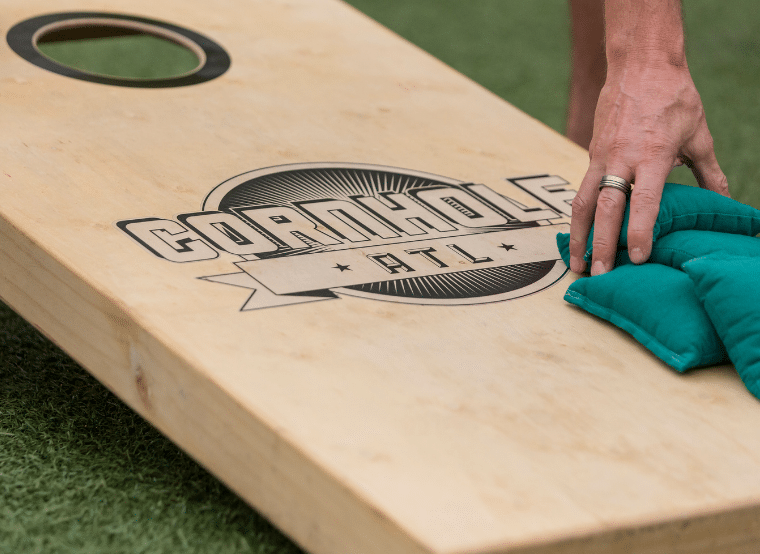
The sun is out, days are getting warmer and spring is on its way. That means more time outdoors and more fun events and activities in and around Peachtree Corners.
From movies and sports to live music and family fun, now’s the time to mark your calendar for all of the upcoming events you won’t want to miss. We’re sharing a few of our April favorites to get you started.
CrossFit on the Green
All ages and fitness levels are invited to join Terrance Fox with CrossFit PPG on the Peachtree Corners Town Green, Thursdays at 8 a.m. for a strength and conditioning workout. Bring water (no glass containers), a small towel or two, and a mat if possible. Wear comfortable workout attire and good shoes. March–November. Admission: free
Peachtree Corners Town Green • 5140 Town Green Blvd., Peachtree Corners
Cornhole Spring League
Come out and cheer on the teams who’ve registered to compete in this seven-week spring league. Play takes place weekly beginning March 20 and ends on May 15 with a tournament and trophy. 6 p.m. to 9 p.m. Admission: free
The Forum at Peachtree Corners • 5155 Peachtree Parkway, Peachtree Corners
Friday Night Live
Kick back and groove to the smooth sounds of live music from favorite local artists every Friday night on The Plaza, April–October. Concert schedule will be announced soon. 6 p.m. to 8 p.m. Admission: free
The Forum at Peachtree Corners • 5155 Peachtree Parkway, Peachtree Corners
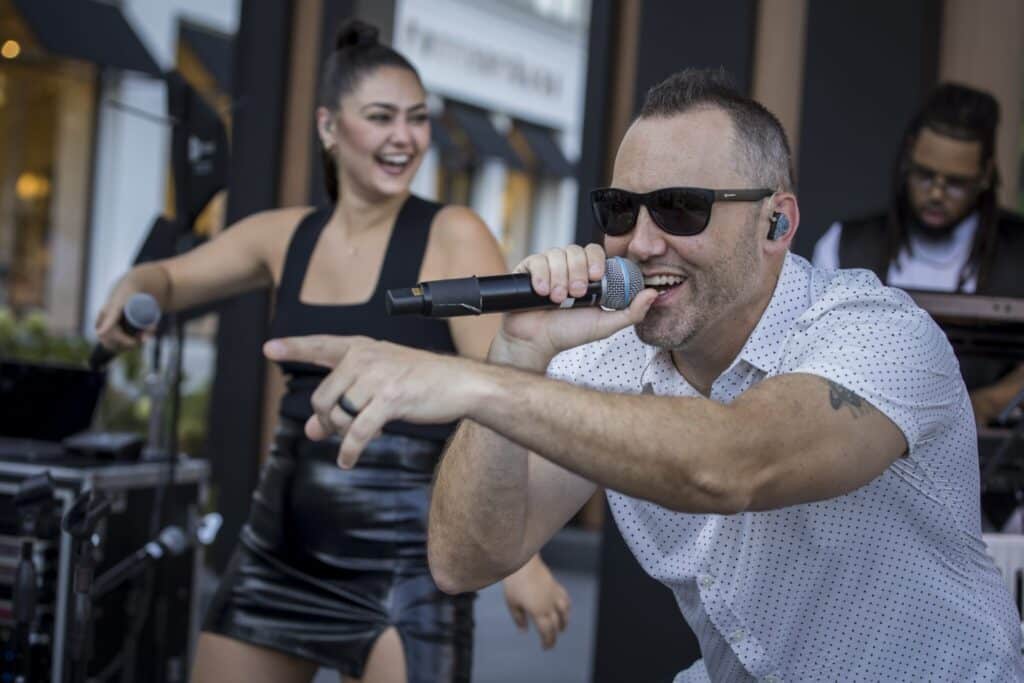
Kids and Parents Gardening Workshop
This gardening workshop presented by nonprofit group DFOWW will share basic gardening information for youth ages 5–12 and their parent or guardian. Seeds, plants and a catered lunch will be provided. Register online. April 5 from 10:30 a.m. to 3:30 p.m. Tickets: $75 per adult; $10 per adult for low-income families
Norcross Cultural Arts and Community Center • 10 College St., Norcross
Forum Flicks
Forum Flicks are back for 2025. Gather on The Plaza and enjoy your favorite movies on the big screen on the second Tuesday of each month. Movie schedule will be announced soon. April–October starting at 6 p.m. Admission: free
The Forum at Peachtree Corners • 5155 Peachtree Parkway, Peachtree Corners
Spring Plant & Pot Sale
Kick off the spring gardening season with this four-day sale of plants and pots. Tomatoes, peppers, herbs, flowers and more will be available for purchase. April 19, 21–23 from 9 a.m. to 3 p.m. on Saturday; 3 p.m. to 7 p.m. Monday–Wednesday.
Peachtree Farm • 356 Research Ct., Peachtree Corners

Earth Day Celebration
Learn about the origins of Earth Day and create seed bombs to take home with you at this all-ages workshop. April 22 from 4 p.m. to 5 p.m. Admission: free. Registration is not required.
Peachtree Corners Library • 5570 Spalding Drive, Peachtree Corners
Mt. Carmel Spring BBQ
Enjoy pork BBQ, Brunswick stew, slaw and desserts. The event will continue until items sell out. Dine in and take out are available. April 25 starting at 11 a.m.
Mount Carmel United Methodist Church • 5100 S. Old Peachtree Rd., Peachtree Corners
Wesleyan Artist Market
This annual two-day market showcase features a curated selection of artwork, handmade goods, jewelry and more, with offerings from professional artists as well as student artists. April 25–26 from 10 a.m. to 7 p.m. on Friday; 10 a.m. to 3 p.m. on Saturday.
Wesleyan School • 5405 Spalding Drive, Peachtree Corners
Spring Fest!
Welcome spring at CtK’s annual Spring Fest! Families are invited to join in for a day of free family fun, food, face painting, a petting zoo and more. April 26 from 11 a.m. to 2 p.m. Admission: free
Christ the King Lutheran Church • 5575 Peachtree Parkway, Peachtree Corners

Curiosity Lab Criterium and Charity 5K Run/Walk
This day-long, family-friendly event on April 27 will feature an inaugural charity 5K Run/Walk to benefit the American Leukemia and Lymphoma Society. Following the race, guests are invited to hang around and experience the Curiosity Lab Criterium, a U.S. Pro Cycling Circuit Race. The 5K starts at 9 a.m.; the bike race begins at 11:15 a.m. There will also be kid’s races, food & beverage vendors, a kids zone, DJ and more throughout the day. From 8 a.m. to 8 p.m.
Curiosity Lab at City Hall • 310 Technology Pkwy NW, Peachtree Corners
Related
Read the Digital Edition
Subscribe
Keep Up With Peachtree Corners News
Join our mailing list to receive the latest news and updates from our team.
You have Successfully Subscribed!

Expanding Horizons: How KGM Technologies Balances Defense, Medical, and Precision Manufacturing

Why Patient Experience Matters: A Conversation with Dr. Aristo Shyn

Burn The Ships: Alex Wright on Committing to Success & Helping Businesses Thrive

Public Notice: Scheduled Maintenance on Town Center Parking Deck

Mike Schleifer to Leave Alliance for Lincoln Center Theater

Inside the Solicitor General’s Office: Lisamarie Bristol on Justice in Gwinnett County

Holy Week, Easter Sunday and Church Events in April

Holy Week, Easter Sunday and Church Events in April

Expanding Horizons: How KGM Technologies Balances Defense, Medical, and Precision Manufacturing

Mike Schleifer to Leave Alliance for Lincoln Center Theater

Public Notice: Scheduled Maintenance on Town Center Parking Deck

Inside the Solicitor General’s Office: Lisamarie Bristol on Justice in Gwinnett County

Why Patient Experience Matters: A Conversation with Dr. Aristo Shyn

Burn The Ships: Alex Wright on Committing to Success & Helping Businesses Thrive

Fun for a Good Cause at Curiosity Lab’s Inaugural 5K Run/Walk

Light up the Corners [Video]

Capitalist Sage: Business Leadership in Your Community [Podcast]

Cliff Bramble: A Culinary Adventure through Italy

Top 10 Brunch Places in Gwinnett County

A Hunger for Hospitality

THE CORNERS EPISODE 3 – BLAXICAN PART 1

Top 10 Indoor Things To Do This Winter

The ED Hour: What it takes to Remove Barriers from Education
